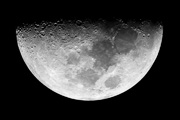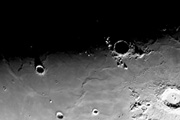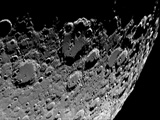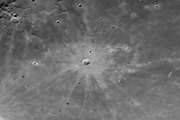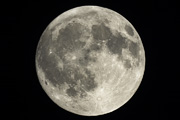Sun & Moon
WARNING:
SUN OBSERVATION WITH IMPROPER EQUIPMENT CAN PERMANENTLY DAMAGE YOUR EYESIGHT. YOU MUST BE FAMILIAR WITH THE RISKS AND PROPER PROCEDURE BEFORE ANY ATTEMPT TO OBSERVE THE SUN WITH AN OPTICAL INSTRUMENT. THE USE OF CERTIFIED SOLAR FILTERS IS MANDATORY.
Total Lunar Eclipse, 15. June 2011.
This eclipse turned out very nice because the Moon passed very close to the center of the Earth's shadow. On the other hand the Moon was rather low over the horizon, which posed additional difficulties when shooting through light polluted urban skies.
Ruđer Bošković Crater
Public Astronomical Observatory of Belgrade is being conducted by the Astronomical Society "Ruđer Bošković", named after the famous 18th century scientist. For that reason, Society's members requested a photograph of the small lunar crater bearing his name.
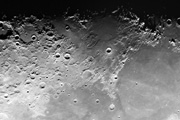
Moon - Ruđer Bošković Crater
Canon EOS 350D on TAL 200K
3x Barlow Lens
1/2s @ ISO100
This small crater is located close to the center of this image. The easier way to find it might be to look for the center of a triangle formed by Julius Caesar crater, Agripa crater and Manilius crater.
Partial Lunar Eclipse 2006.
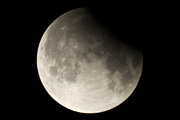
Partial Lunar Eclipse 2006.
Canon EOS 350D on TAL 200K
1/50s @ ISO100
At a focal length of 2000mm, the image of the Moon is larger than the size of EOS 350D's sensor, so this photograph was formed by joining two separate images together.
Sun activity 2006.
This is a selection of images from daily Sun observations conducted for the Observatory archive. Maximum stability of Earth's atmosphere at the imaging site has been registered approximately between 10:00AM and 11:30AM, and most of the images had been taken in that interval. The selection is mostly done based on the details in sunspots.
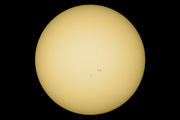
Sun 27.08.2006.
Canon EOS 300D on TAL 200K
0.75x Telecompressor
Baader Astrosolar Filter ND3.8
1/4000s @ ISO100
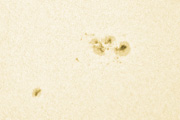
Sun 27.08.2006.
Canon EOS 300D on TAL 200K
2x Barlow Lens
Baader Astrosolar Filter ND3.8
1/320s @ ISO100
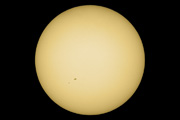
Sun 25.08.2006.
Canon EOS 300D on TAL 200K
0.75x Telecompressor
Baader Astrosolar Filter ND3.8
1/3200s @ ISO100
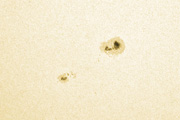
Sun 25.08.2006.
Canon EOS 300D on TAL 200K
2x Barlow Lens
Baader Astrosolar Filter ND3.8
1/320s @ ISO100
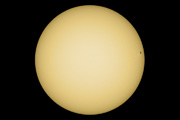
Sun 20.08.2006.
Canon EOS 300D on TAL 200K
0.75x Telecompressor
Baader Astrosolar Filter ND5.0
1/200s @ ISO100
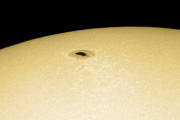
Sun 20.08.2006.
Canon EOS 300D on TAL 200K
2x Barlow Lens
Baader Astrosolar Filter ND3.8
1/250s @ ISO100
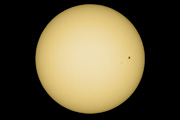
Sun 18.08.2006.
Canon EOS 300D on TAL 200K
0.75x Telecompressor
Baader Astrosolar Filter ND5.0
1/320s @ ISO100
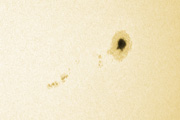
Sun 18.08.2006.
Canon EOS 300D on TAL 200K
2x Barlow Lens
Baader Astrosolar Filter ND3.8
1/400s @ ISO100
Total Solar Eclipse in Turkey 2006.
A group of my friends, associates at the Public Observatory of Belgrade, embarked on a 30 hour journey from Belgrade, Serbia to Manavgat, Turkey to attend the most attractive astronomical phenomenon - the total solar eclipse. The members of the team were: Vladimir Nenezić, Dušan Vučković, Romana Vujasinović, Nenad Stanić, Branko Simonović, Aleksandar Radulović, Aleksandar Otašević and me. After more than a month of technical preparations, we packed more than 200kg of imaging equipment and assembled it on a beach in Manavgat, a small town close to Antaly. This location was selected because it was right along the center line of the eclipse, and besides a nice view of the Mediterranean sea it offered a chance to take a swim during the solar eclipse, a unique opportunity which some team members gladly took advantage of (fortunately without catching a pneumonia).
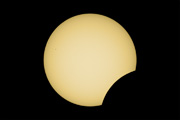
TSE2006 Partial Phases
Canon EOS 350D on 200mm f/6 Newtonian Reflector
1/800s @ ISO100
Baader Astrosolar Filter ND5.0
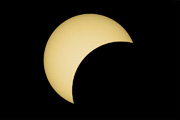
TSE2006 Partial Phases
Canon EOS 350D on 200mm f/6 Newtonian Reflector
1/800s @ ISO100
Baader Astrosolar Filter ND5.0
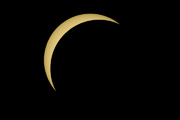
TSE2006 Partial Phases
Canon EOS 350D on 200mm f/6 Newtonian Reflector
1/800s @ ISO100
Baader Astrosolar Filter ND5.0
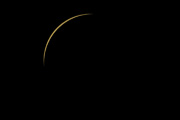
TSE2006 Partial Phases
Canon EOS 350D on 200mm f/6 Newtonian Reflector
1/800s @ ISO100
Baader Astrosolar Filter ND5.0
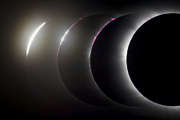
TSE2006 2nd Contact, Baily's Beads, Chromosphere and Prominences
Canon EOS 300D on a Russian MTO 1100mm f/10.5 Lens
1/4000s, 1/2000s, 1/640s, 1/320s @ ISO100
And the filters are taken off. Bright solar photosphere still saturates the sensor of the camera, even though the exposure time is only 250 microseconds. Just before the photosphere dissapears under the lunar disc, a shadow of lunar mountains makes it appear in a form of discontinued segments called the Baily's Beads. As the bright photosphere gets fully covered by the Moon, red solar chromosphere and its magnificent prominences can be seen. Red color of the chromosphere comes from the excited hydrogen atoms, emmiting a characteristic H-alpha spectral line, as the temperature in the chromosphere region is in a range of 4000K. The large prominence seen clearly in the upper part of the 3rd frame is more than three times higher than the diameter of planet Earth. Thin chromosphere layer quickly gets covered by the Moon, leaving only the beautiful solar corona as the eclipse now reaches totality.
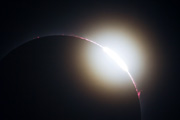
TSE2006 Promineneces
Canon EOS 350D on 200mm f/6 Newtonian Reflector
1/3200s @ ISO100
Sharp optics of our "Kinez" newtonian reflector revealed nice details of the solar prominences just before the 2nd contact. Prominences represent grand scale outbursts of excited gases above the so called "active regions" on the Sun's surface. Image taken by Dušan Vučković.
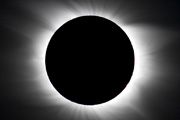
TSE2006 Solar Corona
Canon EOS 300D on a Russian MTO 1100mm f/10.5 Lens
1/8s @ ISO100
A beautiful and mysterious region of solar atmosphere where temperature reaches more than a million Kelvin degrees. In such conditions gases are fully ionized, and corona light is of a different nature than that of a chromosphere. White light of the corona comes from highly ionized nuclei of the heavier elements, as well as from the solar light scattered on various particles. As a consequence of high ionization, most of the particles in corona bear an electrical charge. Sun's magnetosphere highly influences the motion of such particles, so strings and filaments of the corona take shape of the curved magnetic field lines, especially near the solar poles.
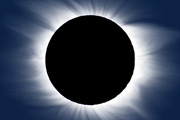
TSE2006 Solar Corona
Canon EOS 300D on a Russian MTO 1100mm f/10.5 Lens
1/8s @ ISO100
The same image as above, but with slightly increased contrast of the filaments, and artificial sky color background.
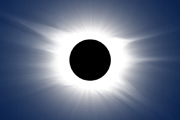
TSE2006 Outer Solar Corona
Canon EOS 20D on a Sigma 400mm f/5.6 Lens
0.5s + 1s @ f/5.6 @ ISO100
Solar corona is a very difficult target to photograph, mainly because of the large difference in brightness of the inner and outer parts. This photograph is composed from two relatively long exposures added together to show its faint outer part. With a temperature of more than a million degrees Kelvin, particles in corona have enough energy to escape the Sun's gravitational pull, forming a so called "Solar wind" which consolidates in a steady flow in the outer region of the corona. Image taken by Vladimir Nenezić.
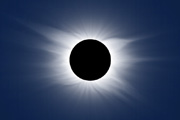
TSE2006 Solar Corona HDR
Canon EOS 20D on a Sigma 400mm f/5.6 Lens
8 exposures from 1/125s to 1s with 1 f-stop step @ f/5.6 @ ISO100
This is a specially processed HDR image showing full detail of the solar corona - the inner and outer part together. Large dynamics of the image has been compressed with total exposure difference of 125 (7 f-stops). Raw images taken by Vladimir Nenezić.

TSE2006 Solar Corona Panorama
Canon EOS 20D on a Sigma 400mm f/5.6 Lens
8 exposures from 1/125s to 1s @ f/5.6 @ ISO100
This is the same as the previous image, but the projection has been chaged to unwind the corona in a flat panoramic image.
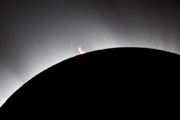
TSE2006 Prominenece and Magnetic Loops
Canon EOS 350D on 200mm f/6 Newtonian Reflector
1/3200s @ ISO100
It has been said previously that prominences form above the active regions on the Sun's surface. These regions are also characterized by the appearance of strong magnetic filed, also associated with sunspots and convective movement of surface matter. Magnetic field is a solenoidal vector field, and its field lines must form closed loops. As the same magnetic field influences the flow of particles inside the corona, we can notice its presence by the formation of loops in the corona right above the large prominence. Image taken by Dušan Vučković.
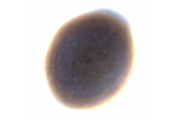
TSE2006 Moon's Surface
Canon EOS 350D on 200mm f/6 Newtonian Reflector
A number of exposures of around 1s @ ISO100
At any time, the side of the Moon facing the observers on Earth is illuminated by faint light called the Earthshine or Ashen Light. This is actually sunlight reflected by the planet Earth, illuminating the Moon and finally returning to be viewed by observers on it. After sundown, it can be seen by naked eye during early phases of the crescent Moon, but during a total solar eclipse this light is way too many times fainter than the bright solar corona. In order to reveal it, a special technique to increase the signal-to-noise ratio in the image was used, which involved adding together a large number of images taken during totality. After careful processing a faint Moon's surface appeared, surrounded by the bright halo of the inner corona. In the lower left corner a Tycho Brahe crater can be seen, and in the upper right Mare Imbrium and Mare Serenitatis.
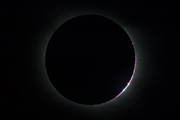
TSE2006 Chromosphere
Canon EOS 300D on a Russian MTO 1100mm f/10.5 Lens
1/500s @ ISO100
The appearance of chromosphere and another set of prominences on the other side of lunar disc announces the end of totality. This is also a sign for visual observers that they should put the filters back on their telescopes for safe viewing.
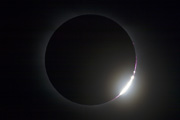
TSE2006 Baily's Beads 3rd Contact
Canon EOS 300D on a Russian MTO 1100mm f/10.5 Lens
1/1000s @ ISO100
Baily's beads appear again as the sunlight rushes over the saddles between lunar mountains.
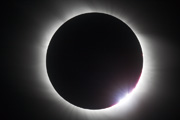
TSE2006 3rd Contact
Canon EOS 350D on 200mm f/6 Newtonian Reflector
1/100s @ ISO100
This image was taken almost exactly at the time of 3rd contact, by Dušan Vučković.
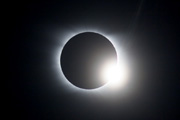
TSE2006 Diamond Ring
Canon EOS 20D on a Sigma 400mm f/5.6 Lens
1/250s @ f/5.6 @ ISO100
If you get your shot timing and exposure just right, a photograph just after the 3rd contact can produce a nice effect called "The Diamond Ring" - a bright round flash of sunlight while the corona is still clearly visible. Diamond Ring can be photographed just before the 2nd contact as well. Image taken by Vladimir Nenezić.
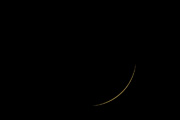
TSE2006 Partial Phases
Canon EOS 350D on 200mm f/6 Newtonian Reflector
1/800s @ ISO100
Baader Astrosolar Filter ND5.0

TSE2006 Partial Phases
Canon EOS 350D on 200mm f/6 Newtonian Reflector
1/800s @ ISO100
Baader Astrosolar Filter ND5.0
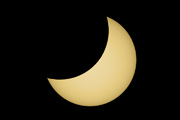
TSE2006 Partial Phases
Canon EOS 350D on 200mm f/6 Newtonian Reflector
1/800s @ ISO100
Baader Astrosolar Filter ND5.0
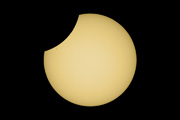
TSE2006 Partial Phases
Canon EOS 350D on 200mm f/6 Newtonian Reflector
1/800s @ ISO100
Baader Astrosolar Filter ND5.0
...and the Moon is about to leave the Solar disk.
Moon Photographs 2005.
A selection of images taken during testing of the astrophotography equipment.





